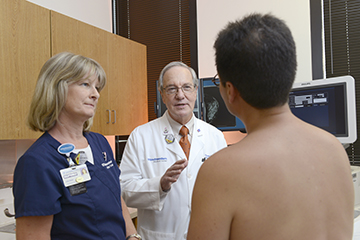
Not a day goes by that breast cancer isn’t part of my conversation. But it’s not always with women. Men can have breast cancer, too, and when they do, they have the same questions as women, they face the same decisions, and they need the same support.
It could be a case of gynecomastia, which is noncancerous swelling of the breast tissue caused by an imbalance of the hormones estrogen and testosterone. Gynecomastia typically occurs at one of three life stages – infancy, puberty, and later in life, often after age 60. Though childhood conditions shouldn’t be ignored, they are more typically related to that hormone imbalance and may resolve without treatment by the age of 18.
Regardless, the signs of gynecomastia – lump, hardened or thickened tissue, or pain around the nipple – are similar to male breast cancer symptoms. They deserve your attention and should be evaluated by your doctor. Male breast cancer, as with most cancer, has better treatment options and better outcomes the earlier it’s caught.
If you have the symptoms and want to determine whether it’s male breast cancer or gynecomastia, mammograms usually reveal the difference.
As with any rare disease, experience in diagnosing and treating male breast cancer becomes important when a patient is selecting care. We’ve treated cases of male breast cancer and provided those patients with diverse treatment options. The treatment options for men with breast cancer are basically the same as for women – as are reactions: Let’s get this diagnosed and treated.
Is male breast cancer common?
Less than a decade ago, male breast cancer wasn’t really on anyone’s health radar, and it’s still rarely a part of the breast cancer conversation. That’s in part because, fortunately, it’s still a rare occurrence – only 1 percent of breast cancer diagnoses are in males. According to the American Cancer Society, only about 2,350 cases are diagnosed annually, which means many physicians and most institutions will never see a single case.What are the symptoms?
Male breast cancer symptoms are similar to women’s – lumps, nipple pain, discharge, and redness or soreness around the nipple area. If you feel a lump or thickened tissue, particularly under the nipple, it’s important not to ignore it – but it’s also important not to panic.It could be a case of gynecomastia, which is noncancerous swelling of the breast tissue caused by an imbalance of the hormones estrogen and testosterone. Gynecomastia typically occurs at one of three life stages – infancy, puberty, and later in life, often after age 60. Though childhood conditions shouldn’t be ignored, they are more typically related to that hormone imbalance and may resolve without treatment by the age of 18.
Regardless, the signs of gynecomastia – lump, hardened or thickened tissue, or pain around the nipple – are similar to male breast cancer symptoms. They deserve your attention and should be evaluated by your doctor. Male breast cancer, as with most cancer, has better treatment options and better outcomes the earlier it’s caught.
How do I perform a self-exam?
We really do not recommend monthly self-examination for men or women. Self-examination has not been shown to reduce deaths from breast cancer. That said, we do promote self-awareness – knowing what your body is like and reporting any change to your health care provider.If you have the symptoms and want to determine whether it’s male breast cancer or gynecomastia, mammograms usually reveal the difference.
What causes male breast cancer?
We’re still trying to identify what causes men to get breast cancer. We do know that it can have a genetic component and that male breast cancer is highly associated with a particular gene mutation called BRCA 2. The gene, which can be passed both to daughters and sons, has been tied to higher risks for both breast cancer and prostate cancer. One option to consider – and it’s recommended for men diagnosed with breast cancer − is genetic testing. The children of men who develop breast cancer have a significantly higher risk of developing breast cancer themselves if they have the genetic mutation.As with any rare disease, experience in diagnosing and treating male breast cancer becomes important when a patient is selecting care. We’ve treated cases of male breast cancer and provided those patients with diverse treatment options. The treatment options for men with breast cancer are basically the same as for women – as are reactions: Let’s get this diagnosed and treated.
If you have questions about male breast cancer, don’t be ashamed. Call us anonymously on the Cancer Answer Line at 214-736-9022 or email us your questions.











